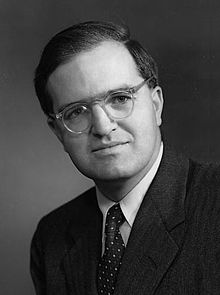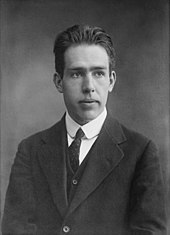Niels Henrik David Bohr (Danish: [ˈne̝ls ˈpoɐ̯ˀ]; 7 October 1885 – 18 November 1962) was a Danish physicist who made foundational contributions to understanding atomic structure and quantum theory, for which he received the Nobel Prize in Physics in 1922. Bohr was also a philosopher and a promoter of scientific research.
Bohr developed the Bohr model of the atom, in which he proposed that energy levels of electrons are discrete and that the electrons revolve in stable orbits around the atomic nucleus but can jump from one energy level (or orbit) to another. Although the Bohr model has been supplanted by other models, its underlying principles remain valid. He conceived the principle of complementarity: that items could be separately analysed in terms of contradictory properties, like behaving as a wave or a stream of particles. The notion of complementarity dominated Bohr's thinking in both science and philosophy.
Bohr founded the Institute of Theoretical Physics at the University of Copenhagen, now known as the Niels Bohr Institute, which opened in 1920. Bohr mentored and collaborated with physicists including Hans Kramers, Oskar Klein, George de Hevesy, and Werner Heisenberg. He predicted the existence of a new zirconium-like element, which was named hafnium, after the Latin name for Copenhagen, where it was discovered. Later, the element bohrium was named after him.
During the 1930s Bohr helped refugees from Nazism. After Denmark was occupied by the Germans, he had a famous meeting with Heisenberg, who had become the head of the German nuclear weapon project. In September 1943 word reached Bohr that he was about to be arrested by the Germans, and he fled to Sweden. From there, he was flown to Britain, where he joined the British Tube Alloys nuclear weapons project, and was part of the British mission to the Manhattan Project. After the war, Bohr called for international cooperation on nuclear energy. He was involved with the establishment of CERN and the Research Establishment Risø of the Danish Atomic Energy Commission and became the first chairman of the Nordic Institute for Theoretical Physics in 1957.
Niels Bohr | |
|---|---|
 Bohr in 1922 | |
| Born | Niels Henrik David Bohr 7 October 1885 Copenhagen, Denmark |
| Died | 18 November 1962 (aged 77) Copenhagen, Denmark |
| Resting place | Assistens Cemetery |
| Alma mater | University of Copenhagen |
| Known for | |
| Spouse(s) | Margrethe Nørlund (m. 1912) |
| Children | Aage, Ernest, four other sons |
| Awards | Nobel Prize in Physics (1922) |
| Scientific career | |
| Fields | Theoretical physics |
| Institutions | |
| Thesis | Studies on the Electron Theory of Metals (1911) |
| Doctoral advisor | Christian Christiansen |
| Other academic advisors | |
| Doctoral students | Hendrik Kramers I. H. Usmani |
| Other notable students | Lev Landau |
| Influences | |
| Influenced | |
| Signature | |
https://en.wikipedia.org/wiki/Niels_Bohr
Aage Niels Bohr (Danish: [ˈɔːwə ˈne̝ls ˈpoɐ̯ˀ] (![]() listen); 19 June 1922 – 8 September 2009) was a Danish nuclear physicist who shared the Nobel Prize in Physics in 1975 with Ben Mottelson and James Rainwater "for the discovery of the connection between collective motion and particle motion in atomic nuclei and the development of the theory of the structure of the atomic nucleus based on this connection".[1] Starting from Rainwater's concept of an irregular-shaped liquid drop model of the nucleus, Bohr and Mottelson developed a detailed theory that was in close agreement with experiments. Since his father, Niels Bohr, had won the prize in 1922, he and his father were one of the six pairs of fathers and sons who have both won the Nobel Prize and one of the four pairs who have both won the Nobel Prize in Physics.[2][3]
listen); 19 June 1922 – 8 September 2009) was a Danish nuclear physicist who shared the Nobel Prize in Physics in 1975 with Ben Mottelson and James Rainwater "for the discovery of the connection between collective motion and particle motion in atomic nuclei and the development of the theory of the structure of the atomic nucleus based on this connection".[1] Starting from Rainwater's concept of an irregular-shaped liquid drop model of the nucleus, Bohr and Mottelson developed a detailed theory that was in close agreement with experiments. Since his father, Niels Bohr, had won the prize in 1922, he and his father were one of the six pairs of fathers and sons who have both won the Nobel Prize and one of the four pairs who have both won the Nobel Prize in Physics.[2][3]
Aage Bohr | |
|---|---|
 Bohr in 1955 | |
| Born | 19 June 1922 |
| Died | 8 September 2009 (aged 87) Copenhagen, Denmark |
| Nationality | Danish |
| Alma mater | University of Copenhagen |
| Known for | Geometry of atomic nuclei |
| Parent(s) | Niels Bohr, Margrethe Nørlund |
| Awards | |
| Scientific career | |
| Fields | Nuclear physics |
| Institutions | |
| Thesis | Rotational States of Atomic Nuclei (1954) |
https://en.wikipedia.org/wiki/Aage_Bohr
Amalie Emmy Noether[a] (US: /ˈnʌtər/, UK: /ˈnɜːtə/ NUR-tər; German: [ˈnøːtɐ]; 23 March 1882 – 14 April 1935) was a German mathematician who made many important contributions to abstract algebra. She discovered Noether's theorem, which is fundamental in mathematical physics.[1] She was described by Pavel Alexandrov, Albert Einstein, Jean Dieudonné, Hermann Weyl and Norbert Wiener as the most important woman in the history of mathematics.[2][3] As one of the leading mathematicians of her time, she developed some theories of rings, fields, and algebras. In physics, Noether's theorem explains the connection between symmetry and conservation laws.[4]
Noether was born to a Jewish family in the Franconian town of Erlangen; her father was the mathematician Max Noether. She originally planned to teach French and English after passing the required examinations, but instead studied mathematics at the University of Erlangen, where her father lectured. After completing her doctorate in 1907[5] under the supervision of Paul Gordan, she worked at the Mathematical Institute of Erlangen without pay for seven years. At the time, women were largely excluded from academic positions. In 1915, she was invited by David Hilbert and Felix Klein to join the mathematics department at the University of Göttingen, a world-renowned center of mathematical research. The philosophical faculty objected, however, and she spent four years lecturing under Hilbert's name. Her habilitation was approved in 1919, allowing her to obtain the rank of Privatdozent.[5]
Noether remained a leading member of the Göttingen mathematics department until 1933; her students were sometimes called the "Noether boys". In 1924, Dutch mathematician B. L. van der Waerden joined her circle and soon became the leading expositor of Noether's ideas; her work was the foundation for the second volume of his influential 1931 textbook, Moderne Algebra. By the time of her plenary address at the 1932 International Congress of Mathematicians in Zürich, her algebraic acumen was recognized around the world. The following year, Germany's Nazi government dismissed Jews from university positions, and Noether moved to the United States to take up a position at Bryn Mawr College in Pennsylvania where she taught, among others, doctoral and post-graduate women including Marie Johanna Weiss, Ruth Stauffer, Grace Shover Quinn and Olga Taussky-Toddone. At the same time, she lectured and performed research at the Institute for Advanced Study in Princeton, New Jersey.[5]
Noether's mathematical work has been divided into three "epochs".[6] In the first (1908–1919), she made contributions to the theories of algebraic invariants and number fields. Her work on differential invariants in the calculus of variations, Noether's theorem, has been called "one of the most important mathematical theorems ever proved in guiding the development of modern physics".[7] In the second epoch (1920–1926), she began work that "changed the face of [abstract] algebra".[8] In her classic 1921 paper Idealtheorie in Ringbereichen (Theory of Ideals in Ring Domains), Noether developed the theory of ideals in commutative rings into a tool with wide-ranging applications. She made elegant use of the ascending chain condition, and objects satisfying it are named Noetherian in her honor. In the third epoch (1927–1935), she published works on noncommutative algebras and hypercomplex numbers and united the representation theory of groups with the theory of modules and ideals. In addition to her own publications, Noether was generous with her ideas and is credited with several lines of research published by other mathematicians, even in fields far removed from her main work, such as algebraic topology.
Emmy Noether | |
|---|---|
 | |
| Born | Amalie Emmy Noether 23 March 1882 |
| Died | 14 April 1935 (aged 53) |
| Nationality | German |
| Alma mater | University of Erlangen |
| Known for | |
| Awards | Ackermann–Teubner Memorial Award (1932) |
| Scientific career | |
| Fields | Mathematics and physics |
| Institutions | |
| Thesis | On Complete Systems of Invariants for Ternary Biquadratic Forms (1907) |
| Doctoral advisor | Paul Gordan |
| Doctoral students | |
https://en.wikipedia.org/wiki/Emmy_Noether


No comments:
Post a Comment